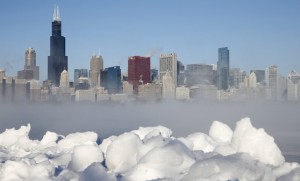As the central and eastern parts of Canada and the United States experience one of the coldest winters we’ve had in many years, there are no shortage of people wondering to themselves as to how can it be so cold, if we are experiencing global warming and climate change?
It’s not too hard to see the rationalization, given how most environmentalists intially began raising the alarm bells by using the term ‘Global Warming’ with great frequency. This is easily a significant piece of environmental news, however the problem is that the situation we are facing due to the never-before seen levels of carbon in our atmosphere, is that of a changing climate and not specically global warming.
The reality is that what we are largely experiencing is a weather phenominon, and weather is but one component of our climate. Where the actual ‘warming’ comes into play is that the temperature of our atmosphere and our oceans is getting warmer due to the fact that more heat is being trapped due to the increased levels of carbon, which act like a barrier for infrared heat to escape. As air begins to warm, it has the ability to retain more moisture. Using the hydrological cycle as a guide where water falls from the atmosphere as precipitation, then eventually evaporates back into the atmosphere, only to fall again – if the proverbial sponge in the sky can hold more water, it will take up more water and drop more water down when it lets go.
Droughts are created by this pattern as are the catastrophic storms we seen when massive amounts of precipitation fall over a specific area in a concentrated fashion. With warmer air comes a changing climate, but this also is true when oceans warm up as well.
As ocean temperatures rise, the ice caps in the Arctic and Antarctic face a double threat (warmer air above and warmer water below). The rapid decline of ice over our polar regions will continue to have an impact over things such as wind directions, ocean currents and most notably, the jet stream.
The jet stream as we all know is a massive regulator of weather patterns. It often acts as a divide between warm and cold and as it’s direction changes, so too do weather conditions and patterns. At the moment the jet stream which normally moves in a rather direct west to east pattern has changed to where massive dips north and south are occurring over North America. The jet stream has veered north from the Pacific and over Alaska which has caused that State to see some of the warmest winter temperatures in it’s history. As the jet stream then veers south, right over the central and eastern parts of North America, it brings with it the cold, arctic air masses that normally keep far to the north. This ‘Polar Vortex’ is the main contributor to our winter – hot and dry in the west, cold and stormy in the east, and many believe the changing conditions in the arctic have had an influence over the jet stream this year.
Given that scientists are amongst the most hestitant and cautious academics out there, very few would be willing to directly link this past winter to that of climate change. However, as the following video demonstrates there are many who would suggest that what we are experiencing is something we can expect to see more and more of as our arctic climate and weather patterns become permanently and irreversably changed due to the effects of increased carbon in our atmosphere – the vast majority of which is caused by man’s obsessive use of fossil fuels.

So when you next hear someone wondering aloud as to how can climate change be real given the frigid winter we’ve been having…you might want to counter with the fact that perhaps it might be because of climate change and not in spite of it.



Leave a Reply